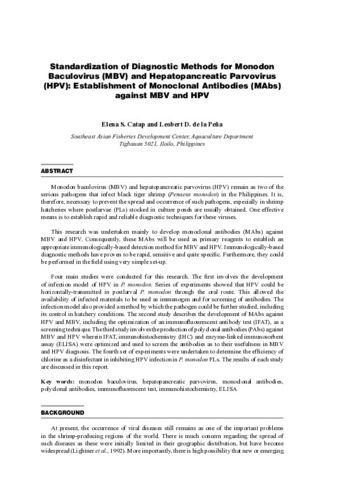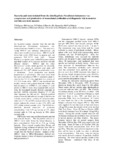Standardization of diagnostic methods for monodon baculovirus (MBV) and hepatopancreatic parvovirus (HPV): Establishment of monoclonal antibodies (MAbs) against MBV and HPV
| dc.contributor.author | Catap, Elena S. | |
| dc.contributor.author | de la Peña, Leobert D. | |
| dc.contributor.editor | Nagasawa, Kazuya | |
| dc.date.accessioned | 2020-07-21T00:48:26Z | |
| dc.date.available | 2020-07-21T00:48:26Z | |
| dc.date.issued | 2005-03 | |
| dc.identifier.citation | Catap, E. S., & de la Peña, L. D. (2005). Standardization of diagnostic methods for monodon baculovirus (MBV) and hepatopancreatic parvovirus (HPV): Establishment of monoclonal antibodies (MAbs) against MBV and HPV. In K. Nagasawa (Ed.), Recent Advances in Diagnosis and Prevention of Fish and Shrimp Diseases in Southeast Asia (pp. 27–28). Tigbauan, Iloilo, Philippines: Aquaculture Department, Southeast Asian Fisheries Development Center. | en |
| dc.identifier.isbn | 9718511732 | |
| dc.identifier.uri | http://hdl.handle.net/10862/5908 | |
| dc.description.abstract | Monodon baculovirus (MBV) and hepatopancreatic parvovirus (HPV) remain as two of the serious pathogens that infect black tiger shrimp (Penaeus monodon) in the Philippines. It is, therefore, necessary to prevent the spread and occurrence of such pathogens, especially in shrimp hatcheries where postlarvae (PLs) stocked in culture ponds are usually obtained. One effective means is to establish rapid and reliable diagnostic techniques for these viruses. This research was undertaken mainly to develop monoclonal antibodies (MAbs) against MBV and HPV. Consequently, these MAbs will be used as primary reagents to establish an appropriate immunologically-based detection method for MBV and HPV. Immunologically-based diagnostic methods have proven to be rapid, sensitive and quite specific. Furthermore, they could be performed in the field using very simple set-up. Four main studies were conducted for this research. The first involves the development of infection model of HPV in P. monodon. Series of experiments showed that HPV could be horizontally-transmitted in postlarval P. monodon through the oral route. This allowed the availability of infected materials to be used as immunogen and for screening of antibodies. The infection model also provided a method by which the pathogen could be further studied, including its control in hatchery conditions. The second study describes the development of MAbs against HPV and MBV, including the optimization of an immunofluourescent antibody test (IFAT), as a screening technique. The third study involves the production of polyclonal antibodies (PAbs) against MBV and HPV wherein IFAT, immunohistochemistry (IHC) and enzyme-linked immunosorbent assay (ELISA) were optimized and used to screen the antibodies as to their usefulness in MBV and HPV diagnosis. The fourth set of experiments were undertaken to determine the efficiency of chlorine as a disinfectant in inhibiting HPV infection in P. monodon PLs. The results of each study are discussed in this report. | en |
| dc.language.iso | en | en |
| dc.publisher | Aquaculture Department, Southeast Asian Fisheries Development Center | en |
| dc.subject | Baculovirus | en |
| dc.subject | Penaeus monodon | en |
| dc.subject | polyclonal antibodies | en |
| dc.title | Standardization of diagnostic methods for monodon baculovirus (MBV) and hepatopancreatic parvovirus (HPV): Establishment of monoclonal antibodies (MAbs) against MBV and HPV | en |
| dc.type | Book chapter | en |
| dc.citation.spage | 27 | en |
| dc.citation.epage | 28 | en |
| dc.citation.bookTitle | Recent Advances in Diagnosis and Prevention of Fish and Shrimp Diseases in Southeast Asia | en |
| dc.subject.asfa | monoclonal antibodies | en |
| dc.subject.asfa | disease recognition | en |
| dc.subject.asfa | ELISA | en |
| dc.subject.asfa | animal diseases | en |
| dc.subject.scientificName | Penaeus monodon | en |
Files in this item
This item appears in the following Collection(s)
-
Recent Advances in Diagnosis and Prevention of Fish and Shrimp Diseases in Southeast Asia [43]
Terminal Report of the Regional Fish Disease Project on “Development of Fish Disease Inspection Methodologies for Artificially-Bred Seeds” Funded by the Government of Japan Trust Fund from 2000 to 2004


 AQD Access only
AQD Access only


